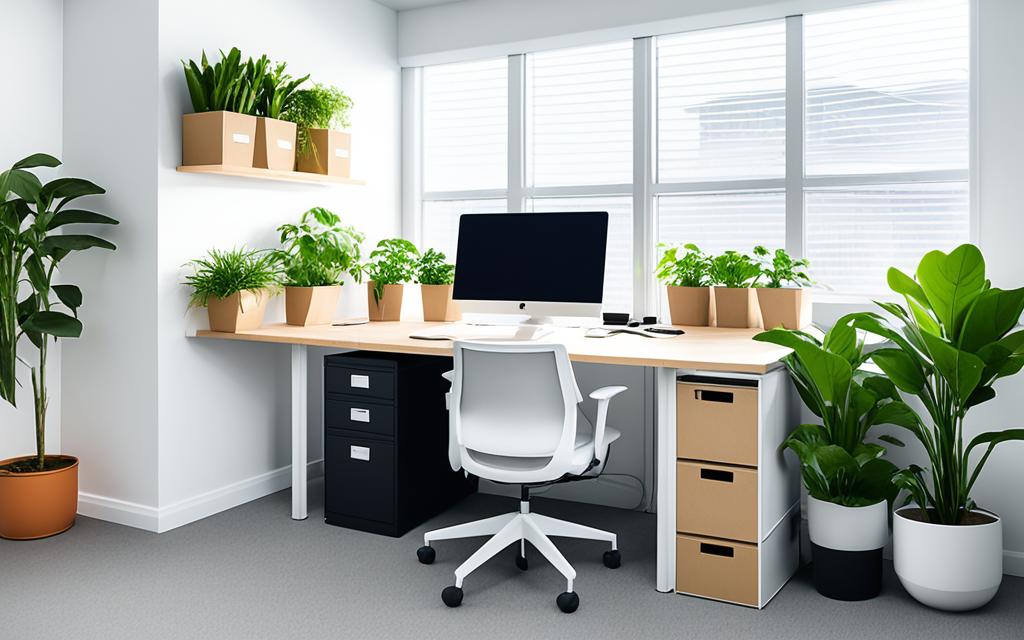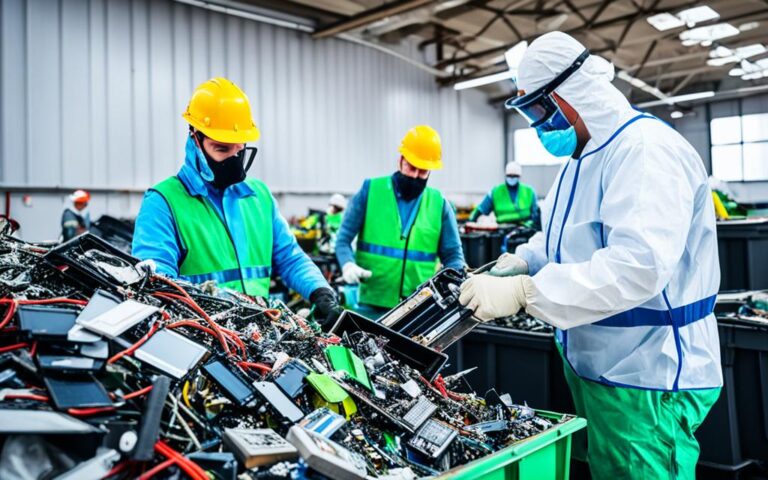Component Harvesting: A Sustainable Workstation Practice
In today’s world, creating a sustainable office space goes beyond using recycled paper or switching off lights when not in use. It involves a holistic approach that considers the environmental impact and promotes eco-friendly computing. One important aspect of sustainability is component utilization, which emphasizes the responsible management and reuse of office equipment and computer hardware.
By employing component harvesting practices, companies can significantly reduce electronic waste and minimize their carbon footprint. Instead of discarding outdated or broken components, these items can be refurbished, recycled, or repurposed, thus extending their lifespan and reducing the need for new manufacturing.
Not only does component harvesting contribute to a more sustainable office environment, but it also presents economic advantages. By reusing and maximizing the usage of existing components, businesses can save on procurement costs and reduce their overall expenditure.
Furthermore, embracing eco-friendly computing through component utilization aligns with corporate responsibility goals and demonstrates a commitment to environmental stewardship. It sets a positive example for employees and stakeholders, encouraging them to adopt sustainable practices both in and out of the workplace.
In the upcoming sections, we will explore the environmental and health consequences of unsustainable offices, the advantages of sustainable office spaces, essential elements for a green office, and the importance of embracing sustainability in the workplace. By understanding and implementing these practices, organizations can create a sustainable and eco-friendly work environment that benefits both the planet and their bottom line.
The Environmental and Health Consequences of Unsustainable Offices
Unsustainable office spaces have a significant impact on the environment and health. They contribute to environmental degradation through energy-intensive buildings, excessive use of non-renewable resources, and inadequate waste management practices. This high carbon footprint accelerates climate change and poses health risks to occupants.
Poor indoor air quality, insufficient natural lighting, and the use of toxic materials in construction contribute to various health issues, from respiratory problems to reduced overall well-being. The lack of proper ventilation and circulation leads to an accumulation of indoor pollutants, such as volatile organic compounds (VOCs) and airborne particles, which can cause respiratory irritation, allergies, and long-term health problems. Additionally, the absence of adequate natural light impacts circadian rhythms and disrupts sleep patterns, leading to decreased productivity and well-being.
In a study conducted by the Indoor Environmental Quality (IEQ) Center, it was found that employees working in sustainable office spaces experienced a 56% reduction in sick leave. This highlights the direct correlation between sustainable office design and improved health outcomes.
According to Dr. Sarah Thompson, a renowned environmental health specialist, “The environmental and health consequences of unsustainable offices are intertwined. The negative impact on the environment not only contributes to climate change but also exacerbates health issues among occupants. It is crucial for organizations to prioritize sustainable practices to protect both the planet and the well-being of their employees.”
To illustrate the damaging effects of unsustainable office spaces on the environment and health, let’s take a closer look at the data:
| Consequences | Environmental degradation | Health issues |
|---|---|---|
| Causes |
|
|
| Impacts |
|
|
It is clear that unsustainable office spaces not only harm the environment but also jeopardize the health and well-being of individuals who spend a significant amount of time in such environments.
Advantages of Sustainable Office Spaces
Creating a sustainable office space offers numerous benefits. One significant advantage is reduced energy consumption, leading to substantial cost savings. Energy-efficient lighting, climate control systems, and renewable energy sources like solar panels contribute to a more environmentally conscious workplace.
Improved air quality, achieved through optimal ventilation, eco-friendly materials, and efficient HVAC systems, positively impacts the overall well-being of employees. Research has shown that good air quality can enhance cognitive function, productivity, and employee satisfaction.
“Improved air quality is a key factor in creating a healthy work environment. Studies have shown that it can reduce the occurrence of sick building syndrome symptoms, such as headaches and respiratory problems. It also promotes a more focused and productive workforce.”
Implementing sustainable office practices not only benefits the environment but also enhances corporate social responsibility and brand reputation. In an era where sustainability and responsible business practices are highly valued, adopting an eco-friendly approach can help distinguish a company as a leader in environmental stewardship.
Sustainable office spaces also contribute to employee satisfaction and productivity. By providing a healthy and environmentally conscious work environment, organizations can attract and retain top talent, boost employee morale, and increase overall productivity.
Table: Key Benefits of Sustainable Office Spaces
| Benefit | Description |
|---|---|
| Reduced Energy Consumption | Energy-efficient lighting, climate control systems, and renewable energy sources reduce energy usage and cost. |
| Improved Air Quality | Optimal ventilation, eco-friendly materials, and efficient HVAC systems contribute to better air quality and employee well-being. |
| Enhanced Corporate Social Responsibility | Adopting sustainable office practices demonstrates a commitment to environmental stewardship and responsible business practices. |
| Positive Impact on Employee Satisfaction and Productivity | A healthy and environmentally conscious workplace fosters employee satisfaction, morale, and productivity. |
Sustainable Office Case Study: Google’s Commitment to Sustainability
Google, a leader in the technology industry, is committed to building sustainable office spaces. The company has made significant investments in renewable energy, sustainable design, and employee well-being. Google’s offices feature energy-efficient lighting, smart thermostats, and solar power installations, significantly reducing energy consumption and carbon emissions.
Furthermore, Google prioritizes employee comfort and well-being by incorporating biophilic design principles and using eco-friendly materials. The company’s offices are adorned with lush greenery, providing a connection to nature and improving air quality.
Google’s sustainable office practices have not only reduced its environmental impact but have also contributed to employee satisfaction and productivity. Employees appreciate the company’s commitment to sustainability and value working in a healthy and eco-friendly environment, resulting in increased job satisfaction and performance.
The sustainable practices implemented by Google serve as a testament to the benefits of creating eco-friendly workspaces. By reducing energy consumption, improving air quality, and focusing on employee well-being, sustainable office spaces can create a more positive and productive work environment.
Essential Elements for a Green Office
Transforming a workplace into a sustainable office space requires incorporating key elements. These include energy-efficient lighting, waste management and recycling programs, biophilic design (incorporating nature into the workspace), and the use of eco-friendly furniture.
One important element of a sustainable office is energy-efficient lighting. By using technologies such as LED lights, offices can reduce electricity consumption and cut costs. Energy-efficient lighting not only decreases the environmental impact but also creates a well-lit and productive workspace.
Another crucial element is waste management and recycling programs. Implementing proper waste management schemes helps minimize the generation of waste and promotes a circular economy. Recycling programs encourage employees to sort and recycle paper, plastics, and other materials, reducing the office’s environmental footprint.
Biophilic design is an innovative concept that brings nature into the office space. By incorporating natural elements like plants, natural light, and natural materials, biophilic design enhances the aesthetics and sustainability of the workspace. Studies have shown that exposure to nature in the workplace improves productivity, reduces stress, and enhances overall well-being.
The selection of eco-friendly furniture is another important consideration for a green office. Opting for sustainable materials, such as recycled or reclaimed wood, reduces the demand for new resources and minimizes the impact on the environment. Eco-friendly furniture not only contributes to a healthier work environment but also reflects the commitment to sustainability.
Benefits of Essential Elements for a Green Office
The incorporation of these essential elements not only makes the office space more sustainable but also brings numerous benefits. Some of the key advantages include:
- Reduced energy consumption and lower energy costs
- Minimized waste generation and increased recycling rates
- Improved employee well-being and productivity
- Enhanced brand reputation and corporate social responsibility
By prioritizing energy-efficient lighting, waste management, biophilic design, and eco-friendly furniture, offices can create a greener and more sustainable work environment.
Embracing Sustainability in the Workplace
Implementing sustainable office practices and green initiatives is crucial for organizations to reduce their environmental impact and promote an eco-friendly work environment. By adopting sustainable practices such as energy-efficient lighting, waste management programs, and the use of eco-friendly materials, businesses can create a greener workspace that benefits both the environment and their employees.
One of the key sustainable office practices is the implementation of energy-efficient lighting systems. By using LED lights and motion sensors, businesses can significantly reduce their energy consumption and decrease their carbon footprint. This not only helps to protect the environment but also leads to cost savings for the organization.
In addition, waste management programs play a crucial role in creating a sustainable office space. By implementing recycling programs and encouraging employees to reduce waste generation, organizations can minimize their environmental impact and contribute to a circular economy. Proper waste management also promotes a cleaner and healthier work environment.
Creating an eco-friendly work environment also involves using sustainable and eco-friendly materials. By opting for furniture and office supplies made from recycled or renewable materials, businesses can further reduce their environmental impact. Additionally, incorporating biophilic design elements, such as indoor plants and natural materials, can improve employee well-being and productivity.
FAQ
What is sustainable office space?
Sustainable office space involves designing workplaces that limit negative impacts on the environment and occupants by prioritizing energy efficiency, eco-friendly materials, waste reduction, and recycling, as well as incorporating features like indoor greenery.
How do unsustainable offices impact the environment and health?
Unsustainable office spaces contribute to environmental degradation through energy-intensive buildings, excessive use of non-renewable resources, and inadequate waste management practices. These offices also pose health risks to occupants due to poor indoor air quality, insufficient natural lighting, and the use of toxic construction materials.
What are the benefits of creating a sustainable office space?
Creating a sustainable office space offers advantages such as reduced energy consumption and cost savings, improved air quality, enhanced corporate social responsibility and brand reputation, and increased employee satisfaction and productivity.
What are the essential elements for a green office?
Essential elements for a green office include energy-efficient lighting, waste management and recycling programs, biophilic design, and the use of eco-friendly furniture.
Why is embracing sustainability in the workplace important?
Embracing sustainability in the workplace is crucial to reduce environmental impact and promote employee well-being. Implementing sustainable office practices not only benefits the environment but also improves brand reputation, employee satisfaction, and cost savings.













